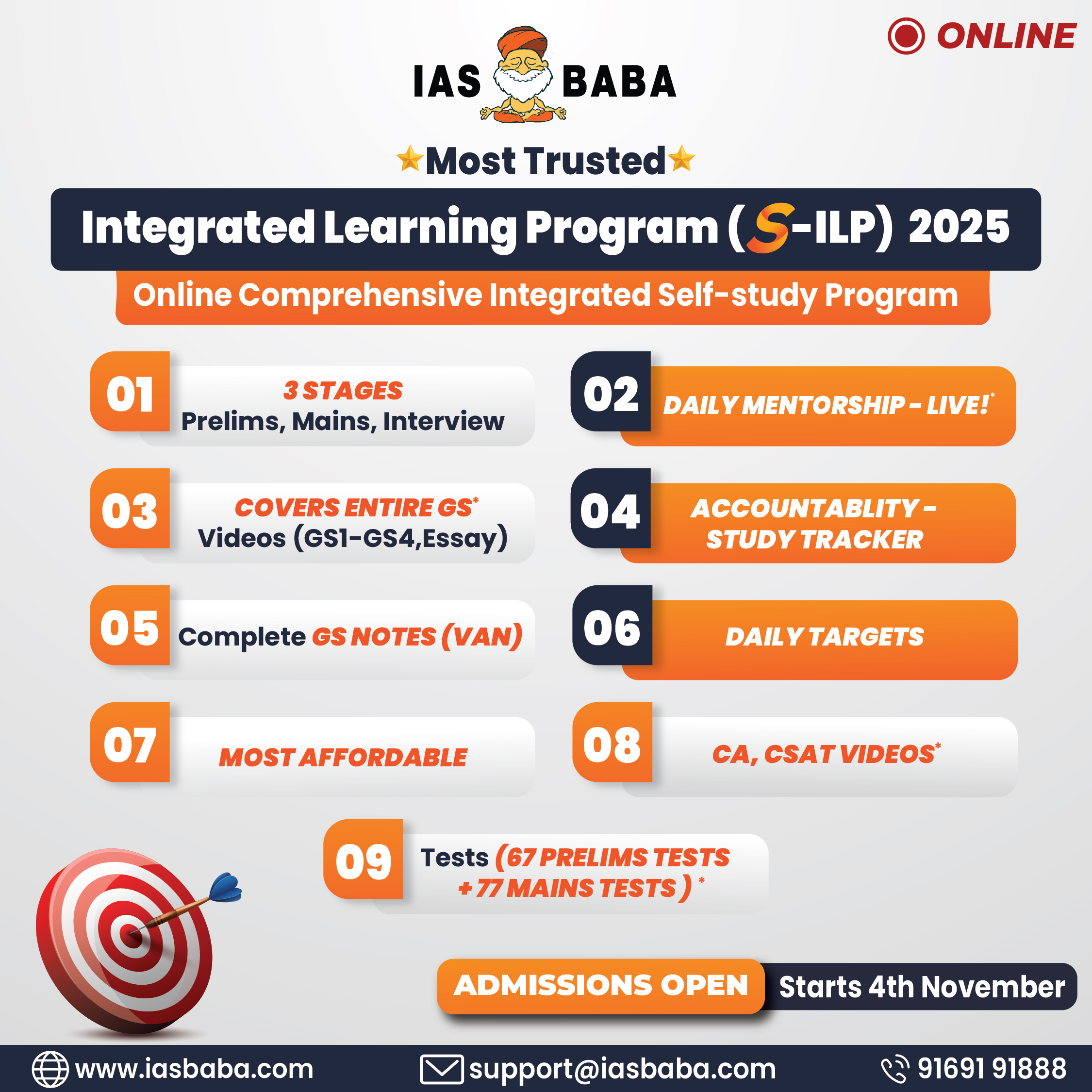IASbaba's Hot Questions, IASbaba's Think Learn Perform 2016, IASbaba's TLP - 2016, Think Learn Perform (TLP)- 2016, UPSC Mains Answer Writing - 2016, UPSC Mains Questions 2016
SYNOPSIS- IASbaba’s TLP 2016 [3rd May] – UPSC Mains GS Questions [HOT]
1. The federal system in India envisages the coexistence of unity and diversity rather than unity in diversity. Comment.
- Intro:
Write a brief introduction.
- Body:
- Reasons, why unity with diversity was envisaged, rather than unity in diversity.
- Legislative – Separate governments and legislatures at State and Centre which are constitutionally recognized.
- Demarcation of powers gives the States authority to govern it according to its diversified needs. State List and Union List are different and implemented simultaneously with concurrent list taking care of issues at both the level. The former takes care of diversity and the latter, unity.
- Creation of Rajya sabha was primarily to the interests of the states, which is manifested in the way the members are elected and way legislative process and Constitutional Amendment Processes are planned
- The 73rd and 74th Amendments to the Constitution empowered local governments with governance system catering to diversity at grassroots level.
- Administrative – Governance of states with their administration, from the State service commissions, for example, provides efficient State administrative machinery by recruiting from the local population.
- Central government provides the necessary coordination and direction required to achieve broader resemblance if not complete uniformity.
- Cooperative federalism and competitive federalism are the new avenues to have growth bottom up, where each state plans and execute plans as per local needs, resources and manpower.
- Financial – The constitution itself classifies and divides certain income sources exclusively to the states, eg: taxes collected by the center but given to states, taxes levied, collected and retained exclusively by states.
- Finance commission, which decides on the quantum of tax sharing between center and states, has progressively increased the states’ share from the divisible pool.
- NITI ayog: formation of NITI ayog has turned the states into equal partners along the Centre in the planning of schemes and programs, which were hitherto imposed upon the passive states.
- Judiciary: Independent judiciary was created to act as neutral adjudicator to protect the states against aggressive center. This has time and again decided in favour of states when the center has breached into states legislative domain.
- Conclusion:
Briefly write a suitable conclusion.
Best answer: RAGHAV
Granville Austin called Indian federalism as “cooperative federalism”. Our federal system envisages coexistence of unity and diversity as follows.
1) Taxing power: Though most of taxes are levied by Centre, the States have the exclusive power to levy taxes on subjects enumerated in the State List such as land revenue, stamp duty on documents, excise duties on alcoholic liquors
2) Constitution amending powers: Bills seeking to amend the federal provision of Constitution such as GST bill cannot be moved without ratification by the States
3) Official language status: Though Hindi is the official language of Union, the States are free to choose their official language thus promoting linguistic diversity.
4) Special provisions to states: States such as Jammu & Kashmir, Assam, Manipur, Nagaland are provided with special provisions to meet the aspirations of the people and to protect the cultural and economic interest of tribal people of the States
5) Legislative powers : As per schedule 7, the matters of regional and local importance and the matters which permit diversity of interest are specified in State list such as agriculture , fisheries etc. States have the exclusive power in making laws with respect to State list.
6) Water sharing: The diversity among states is especially pronounced when sharing natural resources, like water.
7) Zonal Council: Zonal councils aim at promoting cooperation, coordination and diversity of states
8) Rajya Sabha : Our federal system provides for a bicameral legislature containing Rajya Sabha to protect the interests of the states
9) Administrative power: The executive powers of state extend to its territory and within the sphere allotted to them States are supreme except under emergency.
Hence the Indian federation which can be described as a new kind of federation to meet India’s peculiar needs is an unique federation in the world.
2. Explain the significance of India’s location with regards to seabed mineral resources. What strategies should be adopted to tap these resources in a sustainable manner. Discuss the significance of ‘blue economy’ in this regard.
Significance of India’s location with regard to seabed mineral resources: (should cover the below points)
- India surrounded by three water bodies, has 7500 km long coastline and around 2 million sq km of territorial water.
- India has also gained 1.5 million sq km of extended EEZ as a result of legal Continental shelf proved by India and accepted by International Sea Bed Authority.
- Indian, due to its geographical location, is the only country having exclusive rights over one site out of three sites for polymetalic nodules in central Indian Ocean.
- Indian islands, Andaman & Nicobar and Lakshadweep, situated in midst of India Ocean, offers opportunity for seabed mineral.
Sustainable strategies to be adopted to tap seabed mineral resources: (can include some of the following)
- Exploration of seabed resources requires permission of the International Seabed Authority (ISA). Strict standards should be set by ISA to extract resources in sustainable manner.
- UNCLOS must also notify rules to ensure level playing field for various nations without conflict and exploitation of sea bed resource without damaging the ocean ecology.
- Cooperation and knowledge exchange with countries which have adopted sustainable technology or approach for mineral exploitation.
- Greater adoption of technology with collaboration from developed countries like USA that includes satellite imagery, 3D mapping, sea bed explorations, meteorological studies etc. These help in precise exploration and discover the prospective areas.
- Remotely Operated Vehicles should be so made so that they reduce human impact on the ecosystem.
- The minerals should be extracted by avoiding disturbance to flora and fauna and their habitat. Over-exploitation of resources also leads to ecological imbalance.
- Government must spend on R&D for sustainable extraction of minerals, minimizing the pollution of water. Ocean water must be given the same care as is presently given to atmosphere.
Significance of ‘Blue Economy’ (Kindly identify “in this regard” in the question – Therefore, content should stress only on seabed mineral resources)
The concept of Blue Economy is emerging as a new narrative on productive and sustainable engagement with the vast development opportunities that oceanic resources offer. Blue economy aims at optimum and sustainable use of oceanic resources for growth and development.
Significance can include the following –
- Earning livelihood, job creation, achieving holistic growth, empowering native coastal communities and attaining greater social and economic inclusion.
- Providing a boost to coastal and national economies
- Generating new employment, skill-sets and capacities
- Promoting entrepreneurship in new areas of economic activity
- Facilitating the interconnectedness of the regional economy
- Utilising the vast, untapped potential of the Indian Ocean
Best answer: SVSR
India’s protruding geography into the Indian Ocean gives strategic edge over all other littoral nations. With its 7500 km coastline, India’s has strong footing with regard to the reach of seabed mineral resources, they are:
> With the EEZ extending up to 200 nautical miles along the coast, India is authorized to exploit natural resources in a sustainable manner.
> These minerals include mineral nodules like manganese, ore, phosphates (used in fertilisers) and other sea valuables like oysters and pearls.
> Continental shelf regions and delta regions are rich in hydrocarbons. Moreover, they are also rich in fisheries diversity.
Strategies needed to be adopted:
> Greater adoption of technology with collaboration from developed countries like USA that includes satellite imagery, 3D mapping, sea bed explorations, meteorological studies etc.
> Strengthening naval base for becoming ‘net security provider’ in the IOR for upholding freedom of navigation and ensuring security to littoral states.
> Sagarmala project – emphasis on port led development to augment coastal economies.
> Stabilising IORA, BIMSTEC etc., for empowering regional countries to check growing influence in the high seas.
Significance of Blue economy in this regard:
> Blue economy is envisaged to lay path for ocean economy development with the principles of social inclusion, environmental sustainability.
> The guiding principles of blue economy is systems approach with renewable and organic inputs for development – addresses resource scarcity.
> Extension of focus from traditional marine products to maritime activities including shipping services. Thus, it works for employment generation.
Therefore, adopting blue economy strategies on par with international standards is a step in right direction to balance economic development with environmental sustainability.
3. The idea of forming an umbrella regulator for all the financial institutions and related agencies will go a long way in overhauling the financial ecosystem of India. Do you agree? Discuss.
Introduction:
Idea of a umbrella regulator has been mooted for long by Mistry committee to financial sector reform committee under Raghuram rajan in 2007 to FSLRC in 2013 all recommended single regulator from security trading to commodity . FSLRC recommended merger of SEBI, FMC ,IRDA and PFRDA . The process of merging FMC with SEBI has already started.
Merits:
1) It will bring a sense of accountability. In case of taking any policy related or any other decision pertaining to financial system, government can directly communicate with one voice.
2) Correlation and synchronization between financial institutions will become easy. Sometimes the jurisdiction and interest’s of various regulators clash, which makes the problem more complex and prolongs it as well. Unification can solve this problem.
3) It can help in judicial cases related to financial matters. As of now the system is compartmentalized. Different regulating bodies are there but their domain area is fixed. A unified regulator will avoid and control the fraudulent activities.
4) It will eventually reduce the duplicate work done in financial institutions.
5) Quicker grievance redressal mechanisms.
Demerits:
- Lack of expertise.
- Too much government control and hence lack of autonomy.
- Over burdening of the regulator.
- Difficulty in implementation considering huge areas of functioning and diversity of the country.
- Infrastructure building could take time.
Conclusion:
- Give your stand whether you agree or disagree with an unified regulator.
- Recent examples can be quoted.
Best answer: My name is Eshwar
http://a.disquscdn.com/uploads/mediaembed/images/3592/2049/original.jpg











